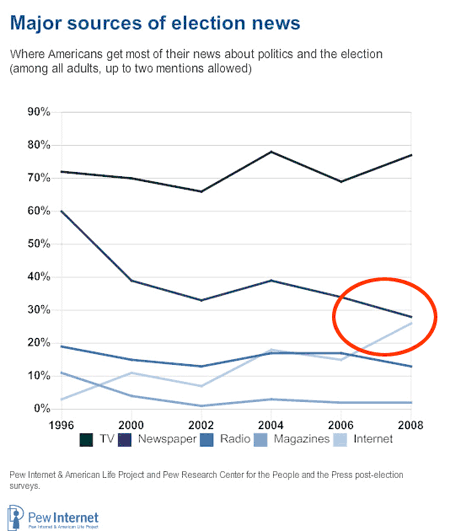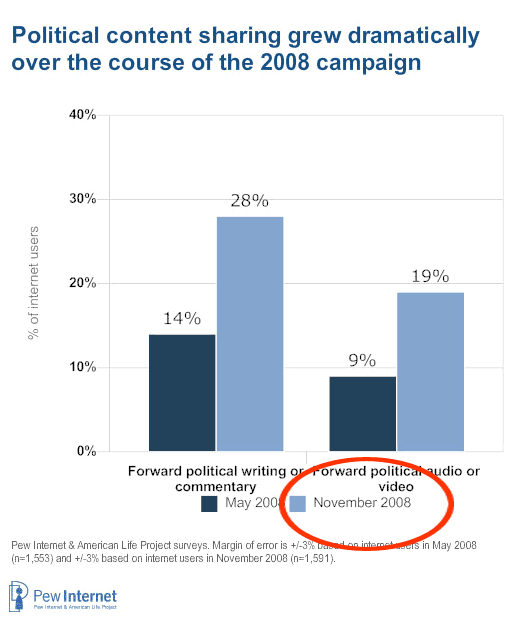To follow up on this intro piece for the treasure trove of data that Aaron Smith put together for Pew, let's take a look at a few of their graphics, with comments about what they show us about ourselves. [I added the red circles to highlight various points.]
Three-quarters (74%) of internet users went online during the 2008 election to take part in, or get news and information about the 2008 campaign. This represents 55% of the entire adult population, and marks the first time the Pew Internet & American Life Project has found that more than half the voting-age population used the internet to connect to the political process during an election cycle.

As you can see, there's a huge drop that we have noted before in newspaper readership, and a big increase in internet viewership for political news, now surpassing radio. The news print line will, of course, continue to drop and the internet line will continue to go up. This has now well-known major implications for the newspaper business model. But, the data in the report really concentrates on the demographic that uses the internet for political news, at least as of 2008.

Not only do young adults rely heavily on the internet (otherwise known as "the future", as in "young adults continue to skew Democratic"), only the 65+ group are heavily into newspapers. Only 20% of adults under 49 listed newspapers as a "most important source". There was little difference between 18-29 and 30-49 year olds.

These days, internet readers aren't passive. 18% of those who read will comment... somewhere. It's not always on blogs; it could be twitter (a tiny fraction in 2008), Facebook, online newspapers, First Read... wherever comments are allowed. However, it helps if you think your comments will be read and interacted with.

More and more people were willing to forward commentary or videos to others. We all had to be seeing increased spam as well as emails from friends that contained the "best of..." that quickly made the rounds. Direct mail (still popular because it's cheap and micro-targeted) was once a powerful tool of right wing foundations and Republican consultants. More recently, the Obama campaign used it to good effect. Now, reaching your network of friends with your personal endorsement that gets the message through spam filters is invaluable.

Naturally, the more you use the internet, the less important to you news print was as an important source. P.S. If you think newspapers are hurting, check out magazines.
None of the above (including commentary on all the other Pew data we didn't cover) is meant to be a "we replace newspapers" post, nor is it meant to suggest that on line sources (which could well be newspapers) are "better". The data simply suggests that political news is shifting away from news print and towards on line sources. That being the case, that's where the journalists will move to.
Six-in-ten internet users went online for news or information about politics in 2008. This represents 44% of all American adults. Nearly one-fifth of the online population got political news on a daily basis during the campaign, as 12% of internet users said they got political news every day and 7% said they did so multiple times over the course of typical day. All told, the overall size of the political news audience has more than doubled since the 2000 elections.

At some point, we'll stop talking about newspapers and we'll start talking about journalism. But, for now, simply note that the younger seekers of information, who skew Democratic with all that implies, are going to be driving this process more and more.
Good, bad, or indifferent, change is coming to the way we get our political news.


